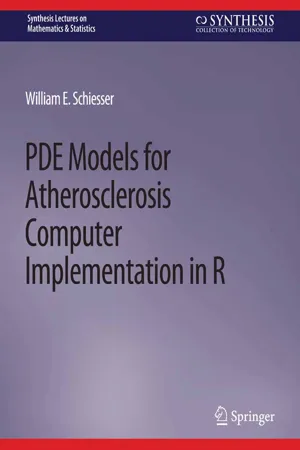
- English
- PDF
- Available on iOS & Android
PDE Models for Atherosclerosis Computer Implementation in R
About This Book
Atherosclerosis is a pathological condition of the arteries in which plaque buildup and stiffening (hardening) can lead to stroke, myocardial infarction (heart attacks), and even death. Cholesterol in the blood is a key marker for atherosclerosis, with two forms: (1) LDL - low density lipoproteins and (2) HDL - high density lipoproteins. Low LDL and high HDL concentrations are generally considered essential for limited atherosclerosis and good health.
This book pertains to a mathematical model for the spatiotemporal distribution of LDL and HDL in the arterial endothelial inner layer (EIL, intima). The model consists of a system of six partial differential equations (PDEs) with the dependent variables
1. (, ): concentration of modified LDL
2. ?(, ): concentration of HDL
3. (, ): concentration of chemoattractants
4. (, ): concentration of ES cytokines
5. (, ): density of monocytes/macrophages
6. (, ): density of foam cells
and independent variables
1.: distance from the inner arterial wall
2.: time
The focus of this book is a discussion of the methodology for placing the model on modest computers for study of the numerical solutions. The foam cell density (, ) as a function of the bloodstream LDL and HDL concentrations is of particular interest as a precursor for arterial plaque formation and stiffening.
The numerical algorithm for the solution of the model PDEs is the method of lines (MOL), a general procedure for the computer-based numerical solution of PDEs. The MOL coding (programming) is in R, a quality, open-source scientific computing system that is readily available from the Internet. The R routines for the PDE model are discussed in detail, and are available from a download link so that the reader/analyst/researcher can execute the model to duplicate the solutions reported in the book, then experiment with the model, for example, by changing the parameters (constants) and extending the model with additional equations.
Frequently asked questions
Information
Table of contents
- Cover
- Copyright Page
- Title Page
- Contents
- Preface
- PDE Model Formulation
- PDE Model Implementation
- PDE Model Detailed Analysis
- PDE Model Applications
- Author's Biography
- Index